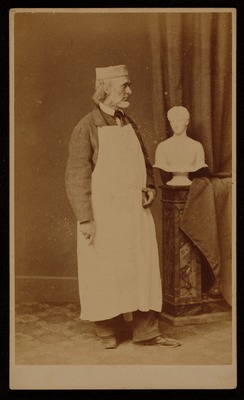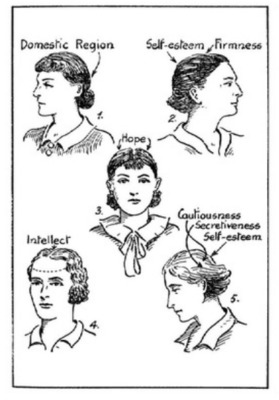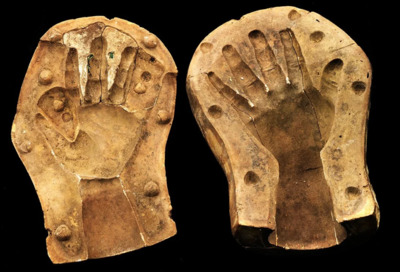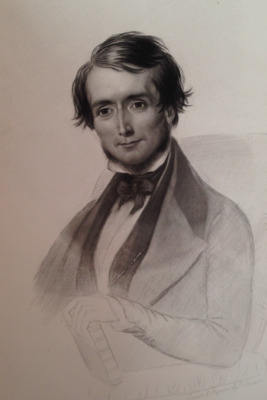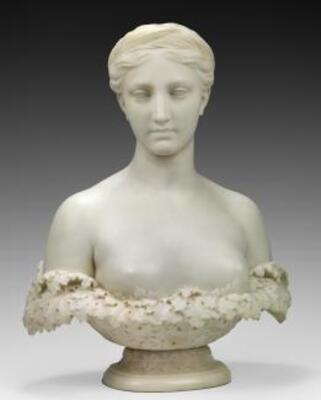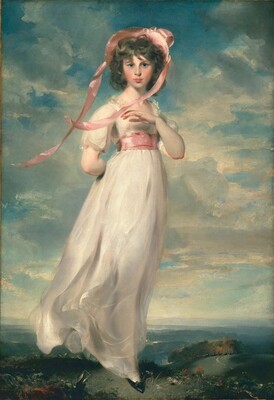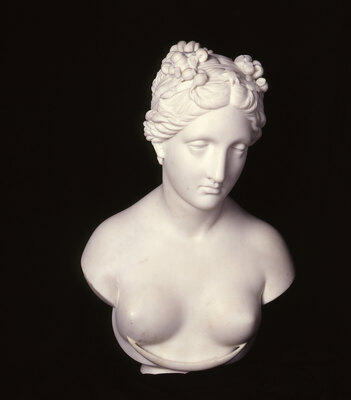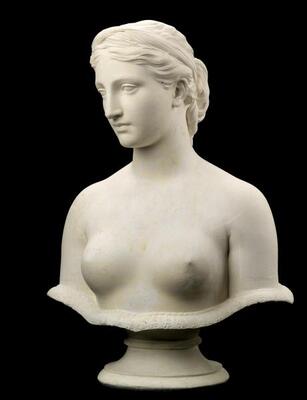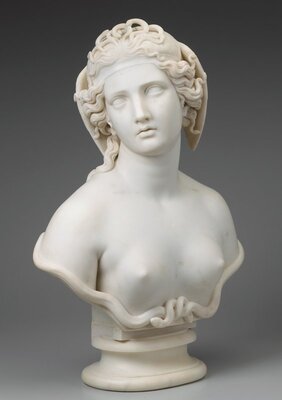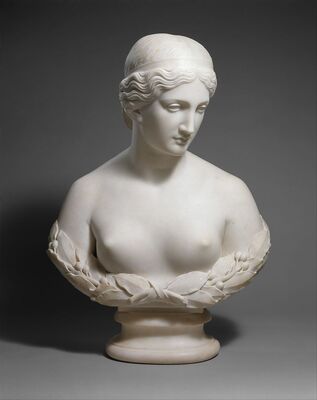Proserpine: "the superficial notions of good taste and the beautiful"
Final Project for 19th Century American Art, Winter 2022
Introduction In this text, we will explore the different ways in which Powers was both shaped by the conservative social climate, and in other ways furthered it. Separate from the historical context, there are three sections (numbered below) on Powers’ hold on 19th-century sculpture: his use of phrenology, Roman allegory, and what artistic trends and criticism reveal about his morals. It is our belief that Powers intended to create works that were inarguably beautiful and perfect, but did so with racist and sexist idealization, and used Western myth to cover female nudity with a veil of violation. Upbringing: The Role of Phrenology Hiram Powers was born to Sarah & Stephen II Powers on June 29th, 1805, on the farm built by his grandfather (Stephen I) in Woodstock, Vermont. An influential period in his life, this was where his mother established his fascination with phrenology. It was also here that he earned the nickname “Hi Powers” for his proficiency with firearms, which would contribute to his later mechanical creations (Wunder 9-13).
Phrenology, established in 1796 by Dr. Franz Gall, was a pseudoscience which declared that skull features and measurements predict mental traits. The more prominent a region, the more a specified trait was said to be expressed. This was often used by dominant groups to enforce stereotypes and dehumanization based on race/class/sex, as seen in the gradient on the left. Phrenology believed that perfection was a spectrum from Eurocentric features of ancient Greek sculpture toward that of animals, and people-of-color as the “in-between.” It was not debunked until the 1840s but was still referred to afterward (Moss 3-17). Hiram Powers’ work is a prime example of the effect of phrenology on antebellum sculpture, (Colbert 281-298). Powers based his method of proportions on the phrenology guides and craniometer measurements of the time. This implicates a larger problem: the intrinsic relationship between prejudice and phrenology, and its immortalization in marble. As statues were hailed as standards for physical perfection, it further alienated and degraded marginalized groups in 19th century America. It can be inferred that Powers was trying to portray characteristics in Proserpine’s face without saying a word, despite unfounded accuracy. According to phrenology, we can imagine Proserpine’s traits through Powers’ eyes.
The domestic region of the female skull was the occipital lobe area, where a prominence indicated fitness for domesticity. While covered with a bun, this accentuates the area, implying Proserpine has a meek and submissive personality. Her forehead is neither prominent nor sloping, indicating Powers did not mean to convey significant intelligence, She is overall quite genuine due to her downward sloping parietal bone. A hopeful attitude is indicated by any prominence on the frontal bone, back toward the coronal suture. From a side perspective, this area looks relatively flat, but it is indiscernible due to her hair covering it. Another thing to note is her absolute adherence to caucasian beauty standards of the time; another tenet of phrenology. History & Methodology of Proserpine Although Powers is remembered as an influential sculptor, he was actually a skilled machinist. Creating one of the first pointer machines, punch machine, and screw-maker (for his plaster casts). Additionally, his unorthodox use of a perforated file and spiked roller contributed for his famous rendition of skin. It was said no other paralleled his ability to render skin at the time, and was one of Greek Referring once again to the archival image of Powers in the introduction, it is interesting to note that he appears to be the sculptor of Proserpine as he wears an apron and hat of a craftsman and holds a sculpting tool in his right hand. To understand Proserpine, we must understand Powers’ relationship with the sculpture’s benefactor: Edward L. Carey. The basket of narcissus flowers on which the bust sits was a last-minute add-on by Powers before the marble bust was to be given to the publisher (Carey often published Powers’ latest creations in Philidelphia). The plaster predecessor was completed in 1843, but the marble carving was delayed to Carey’s dismay. This was because Powers’ set his assistant onto finalizing the marble version of Greek Slave and Eve, with Proserpine on the back burner. Carey, upset, received a daguerreotype taken of Powers and Proserpine, pictured in introduction, was actually sent to Carey to placate him. This one is the first attempt and original, that was to be re-created for the flower basket version. The Smithsonian possesses this version; with the latter at UMMA. Unfortunately, due to Powers’ performative nature, he created more trouble. Going back on his word, he kept the bust after completion to show prospective clients and increased the price to Carey. Carey effectively scolded him, and Powers did not raise the price. Proserpine ended a tragic piece. Powers was to send it to the terminally ill commissioner but kept it for even more time to secure publicity and replica orders. At that time, the benefactor (Carey) died, one of his last wishes being to see the piece (Wunder 137-140). Public’s Response: Outcry & Praise Beyond critics, Powers’ work, and specifically Proserpine became hugely popular among the general public. Hints of the artists’ status are as widespread as 19th century classified ads: an 1854 ad in The Sun promotes subscriptions for an “Illustrated Magazine Of Art,” the likes of which include five works by Powers. The ad itself is notable for the way it uses Powers as a means of promotion-his name, and his work-among them Proserpine and The Greek Slave- are notable enough to be recognized by an interested subscriber. In fact, Proserpine was to become the most replicated work by a 19th century American sculptor- more than three hundred copies were carved in Powers’ studio and are available for viewing across the world today. Mythology & Societal Trends
The mid-19th century was a flourishing time for American neoclassical sculptors in Italy. As a fellow American expatriate, and one generation behind Powers who moved to Florence in 1837, Harriet Hosmer was living and working in Rome beginning in 1852. Hosmer’s first original sculpture, Hesper, was finished within the first year of her expatriatism and twelve years after the public release of Prosperpine. Hesper is pictured here alongside two other busts that Hosmer created: Daphne and Medusa (1854). Upon comparison, one may notice that all four busts are of similar style and subject matter: white marble stone crafted to depict mythological figures in a nude female figure which have similarly framed breasts. And, arguably, all subjects of captivated women. Melissa Dabakis, author of A Sisterhood of Sculptors, writes about the appeal of the ideal female figure as subject matter by saying that: “Neoclassicism was a product of Enlightenment thinking in its fascination with the antique past and the ideal nude. The concept of the ideal has been central to Western culture since the Greeks, serving as the means by which humans acknowledge, and redress, their limited comprehension of the cosmos, that is, their inability to apprehend the absolute. In claiming to embody universal and eternal values, the ideal nude mediates the historical opposition between the transcendent and the material, thus giving visual form to a pure idea through a perfected human body.” Additionally, Dabakis writes about the appeal of the captivated woman as subject matter as being: "caught between two worlds, they inhibited a transitional space that implied an elicit passage from virginity to sexual experience and from domesticity to wilderness. Uncontrolled by rules of bourgeois femininity, these captives maintained lives that were potentially outside the bounds of true womanhood." From Dabakis' writing, we were able to recognize another layer of meaning behind the mythological, idealized, nude, captivated female figure as a popular subject matter. It may also be relevant that both nations, Italy and the United States, were on a quest for an “ideal” and “enlightened” republic government during this time, and because Americans believed that knowledge of the classical past was necessary to such a republic, it was perhaps important to these sculptors to reiterate stories from Greek mythology to audience of their native country. And by doing so through a captivated, nude, female figure, the sculptors were able to captivate the antebellum American gaze which was adverse to nudity, as well as captivity of white figures. Perhaps this shock value added to the rise in publicity, and ultimately fame, of Powers and Hosmer. Closing Statements Bibliography "A Visit to Hiram Powers.: From the Boston Transcript." 1857.New York Daily Times (1851-1857), Jul 25, 3. https://proxy.lib.umich.edu/login?url=https://www-proquest-com.proxy.lib.umich.edu/historical-newspapers/visit-hiram-powers/docview/95920114/se-2?accountid=14667. “Acquisition of Lawrence’s Red Boy | Press Releases | National Gallery, London.” Accessed April 21, 2022. https://www.nationalgallery.org.uk/about-us/press-and-media/press-releases/acquisition-of-lawrences-red-boy. Bindman, D., 2002. Ape to Apollo: Aesthetics and the Idea of Race in the 18th Century. Reaktion Limited. Booktraces.library.virginia.edu. 2016. Book Find: Phrenology, a seemingly silly vintage science with dangerous consequences | Book Traces @ UVA. [online] Available at: <https://booktraces.library.virginia.edu/book-find-phrenology-a-seemingly-silly-vintage-science-with-dangerous-consequences/> [Accessed 20 April 2022]. “Classified Ad 13.” The Sun. March 9, 1854. Proserpine Hiram Powers. Colbert, C., 1986. Each Little Hillock Hath a Tongue. [online] Www-jstor-org.lp.hscl.ufl.edu. Available at: <https://www-jstor-org.lp.hscl.ufl.edu/stable/pdf/24029413.pdf?ab_segments=0%252Fbasic_search_gsv2%252Fcontrol&refreqid=excelsior%3A85be85b8afa95024e373da740262b4fe> [Accessed 20 April 2022]. Dabakis, M., 2014. A Sisterhood of Sculptors. University Park, Pennsylvania: The Pennsylvania State University Press. Fine Art America. 2022. Incredibly Unique Art | Fine Art America. [online] Available at: <https://fineartamerica.com/featured/a-bust-of-proserpine-hiram-powers.html.> [Accessed 20 April 2022]. "HIRAM POWERS." 1873.Chicago Daily Tribune (1872-1922), Jun 29, 8. https://proxy.lib.umich.edu/login?url=https://www-proquest-com.proxy.lib.umich.edu/historical-newspapers/hiram-powers/docview/171422338/se-2?accountid=14667. "Hiram Powers--New Statues." 1852. New York Daily Times (1851-1857), Nov 25, 7. https://proxy.lib.umich.edu/login?url=https://www.proquest.com/historical-newspapers/hiram-powers-new-statues/docview/95799453/se-2?accountid=14667. Janik, E., 2014. The Shape of Your Head and the Shape of Your Mind. [online] Cogsci.ucd.ie. Available at: <https://cogsci.ucd.ie/oldfiles/introtocogsci/docs/Phrenology.pdf> [Accessed 20 April 2022]. Kelly, E., 2018. 33 Images from the ‘Science’ That Thought Your Life Was Determined by Head Shape. [online] All That's Interesting. Available at: <https://allthatsinteresting.com/phrenology-charts#7> [Accessed 20 April 2022]. Minneapolis Institute of Art, n.d. Medusa. [image] Available at: <https://collections.artsmia.org/art/81074/medusa-harriet-goodhue-hosmer> [Accessed 21 April 2022]. Mosse, G. and Browning, C., 2020. Toward the final solution. the University of Wisconsin Press. OLINSKI. 1864. "Foreign Correspondence of the Cincinnati Enquirer.: The War in Europe, NEW COMPLICATIONS EXPECTED DAILY. THE DOINGS OF THE CARNIVAL American Artists in Florence. &c.," The Cincinnati Daily Enquirer (1852-1872), Mar 11, 1. https://proxy.lib.umich.edu/login?url=https://www-proquest-com.proxy.lib.umich.edu/historical-newspapers/foreign-correspondence-cincinnati-enquirer/docview/877137189/se-2?accountid=14667. Powers, H., 1843. Proserpine. [online] Smithsonian American Art Museum. Available at: <https://americanart.si.edu/artwork/proserpine-20131> [Accessed 20 April 2022]. Sartain, J., 1847. Edward L. Carey. [Etching, engraving and mezzotint on off-white wove paper]. Smithsonian American Art Museum, n.d. Proserpine. [image] Available at: <https://americanart.si.edu/artwork/proserpine-20132> [Accessed 21 April 2022]. “The Greek Slave.” Art Object Page, 2022. National Gallery of Art. Available at: <https://www.nga.gov/collection/art-object-page.166484.html. > The Metropolitan Museum of Art, n.d. Daphne. [image] Available at: <https://www.metmuseum.org/art/collection/search/11157> [Accessed 21 April 2022]. Watertown Free Public Library (MA), 2016. Hesper | Harriet Goodhue Hosmer. [image] Available at: <https://www.flickr.com/photos/watertownpublib/27058664023> [Accessed 21 April 2022]. Wecker, M., 2015. The Scandalous Story Behind the Provocative 19th-Century Sculpture "Greek Slave". [online] Smithsonian.com. Available at: <https://www.smithsonianmag.com/smithsonian-institution/scandalous-story-behind-provocative-sculpture-greek-slave-19th-century-audiences-180956029/> [Accessed 20 April 2022].
Wunder, R., 1991. Hiram Powers: Vermont Sculptor, 1805-1873. Newark: Univ. of Delaware Press.
Proserpine, with her smooth, pale white marble skin, was praised by 19th century critics as “magnificent” and “the finest of marble.” An 1852 New York Daily Times article, written by the President of Marietta College, proclaims Proserpine to be an “...intuitive and perfect conception of the beautiful.”
Praise was also abundant for the artist himself-a 1957 New York Daily Times article details a visit to Powers’ studio, the striking presence of Proserpine, and the amiable character of Powers; “He is indeed a genial, intelligent, and noble man-would that more of the Americans seen abroad had some of his many excellencies of character.” Not only was Powers celebrated by critics, his values and behavior as an artist were set by some critics as the standard for who an artist should be.
In the same hand, and as is the case with all artists susceptible to critique, Powers was not devoid of controversy. Though Proserpine was celebrated across the board, his release of The Greek Slave in 1843 was met with decidedly less unanimous acceptance. A comparison of the two figures will show many similarities: both Proserpine and The Greek Slave portray women cut from smooth marble, their bare breasts on display.
Each piece pays homage to ancient Greece both visually and through storytelling, but there are clear differences which were identified in audiences which came to see each work. Chiefly, in the sense of mobility and freedom. As a bust, Proserpine is an immobile, or captive female figure. She has no limbs to escape, and is therefore forever trapped in a longing stare somewhere beyond the viewer. The Greek Slave, in contrast, portrays a female figure entirely in the nude, her hand only slightly covering her lower region as a suggestion of modesty. While the two pieces certainly harbor many similarities, Proserpine, a symbol of devine beauty for the art world, was ultimately used in contrast for critiques of The Greek Slave. In one of the most famous critiques of The Greek Slave Jarves, a famous American art collector, critic, and newspaper editor writes:
"It would have been better for the permanent fame of Powers if he had confined himself to bust-making. His facility in giving the likeness, refined by his sense of beauty and popular wax-like finish, make him the favorite sculptor of wealth and fashion. [In this respect, Mr. Powers was to sculpture that Mr. Healy is to painting.] Like Sir Thomas Lawrence and Sir Thomas Lily, in painted portraits, he is sure to gratify his sitters by satisfying the superficial notions of good taste and the beautiful.”
Easy comparisons can be drawn between the works of Sir Thomas Lawrence and Powers’ Proserpine. The English portrait painter was known for pale, idealized portraiture, examples of which can be seen in his pieces, Pinkie (1794) and The Red Boy (1825). Neither the work of Sir Thomas Lawrence, nor Powers’ Proserpine, challenges a viewer merely looking for “the superficial notions of good taste and the beautiful.” The Greek Slave, in contrast, asks the viewer to confront a fully mobile woman, and one who is attempting to break free.
Created For
K-12 EducatorK-12 Student
Museum Visitor
UMMA Docent
UMMA Staff
University Faculty
University Student
Rate this Resource
AVG: 5.0 | Ratings: 2
& Author Notes
All Rights Reserved (Madison K. Flood, Caroline Knight, Honor Robertson)Last Updated
April 26, 2022 1:35 a.m.Report
Reporting Policy
